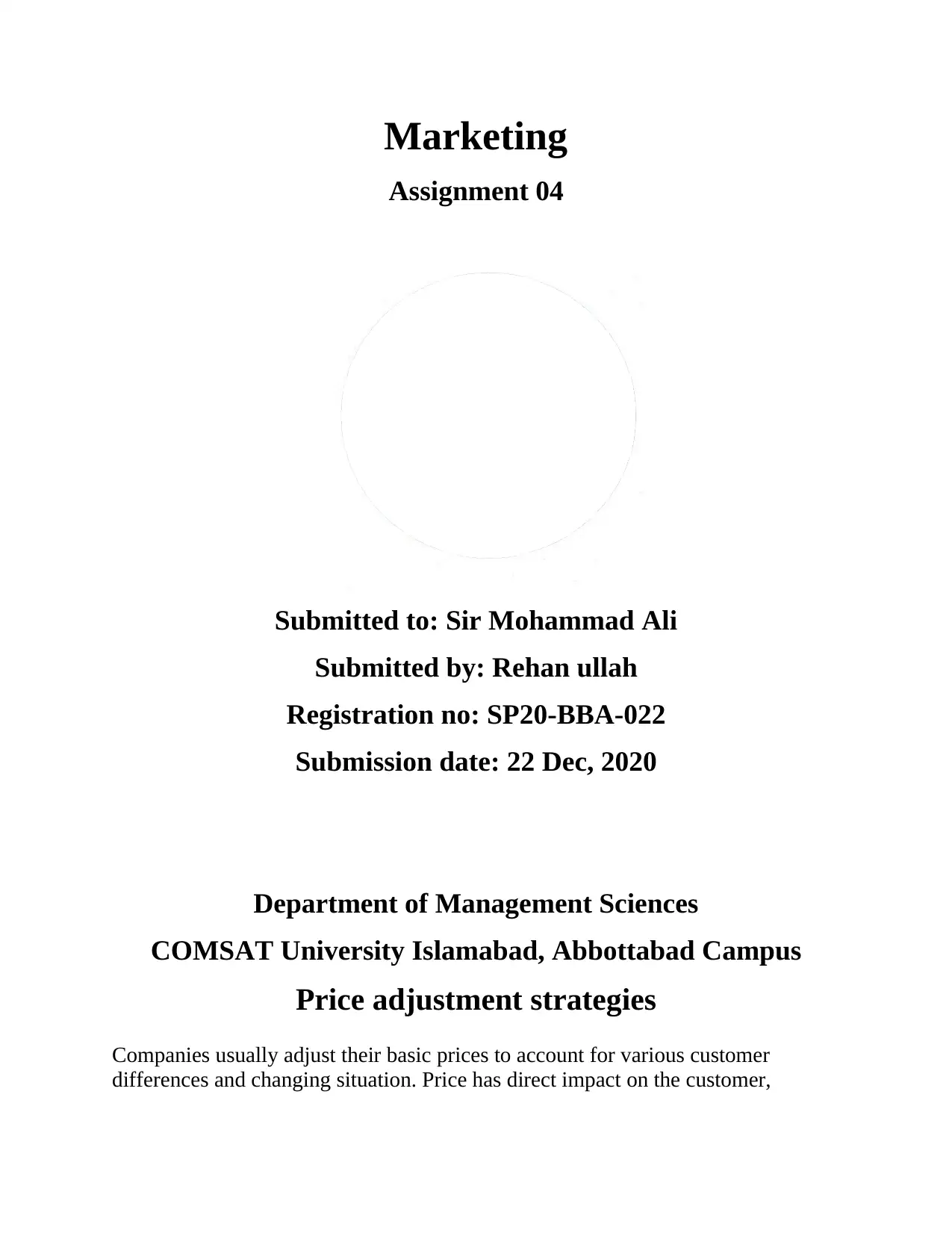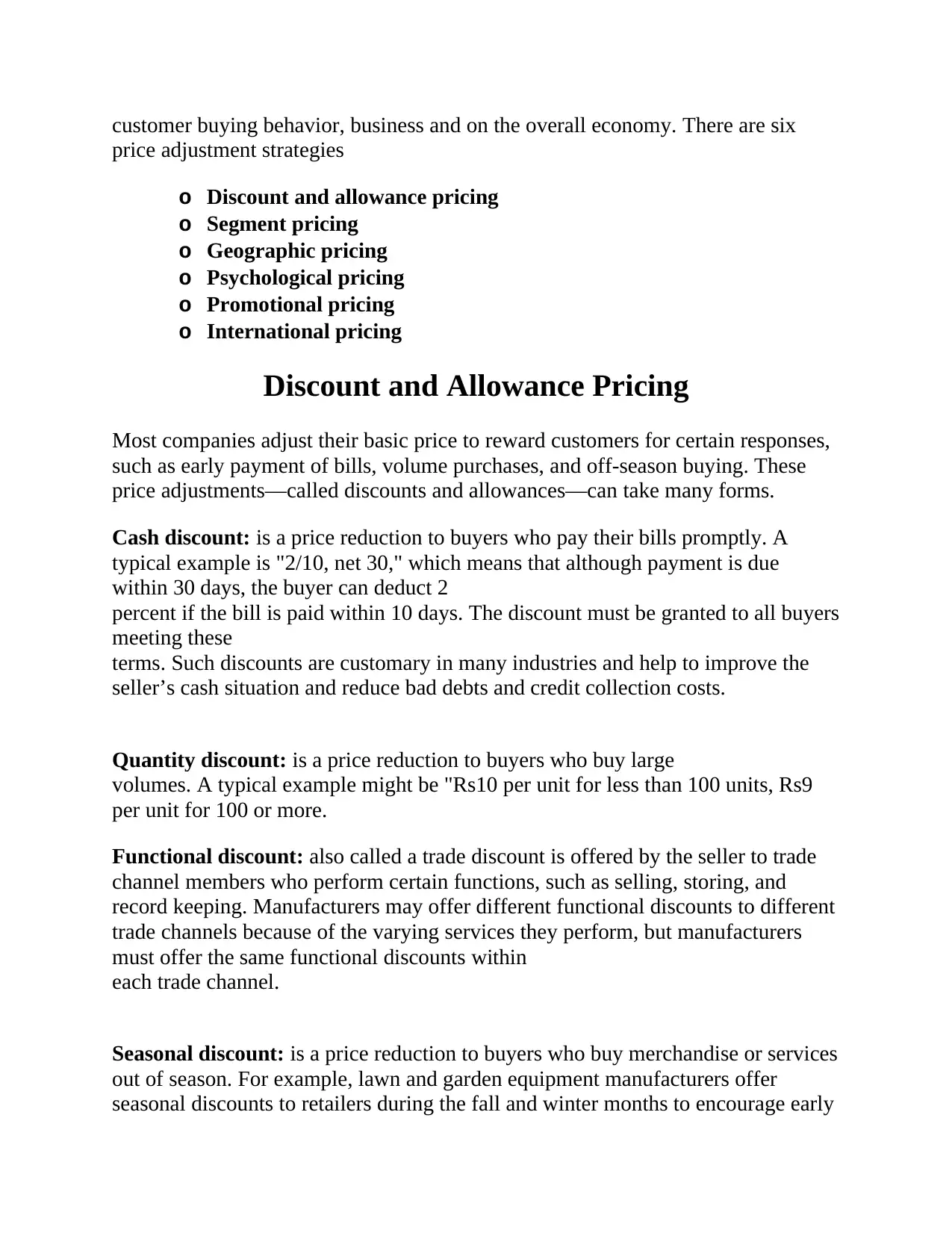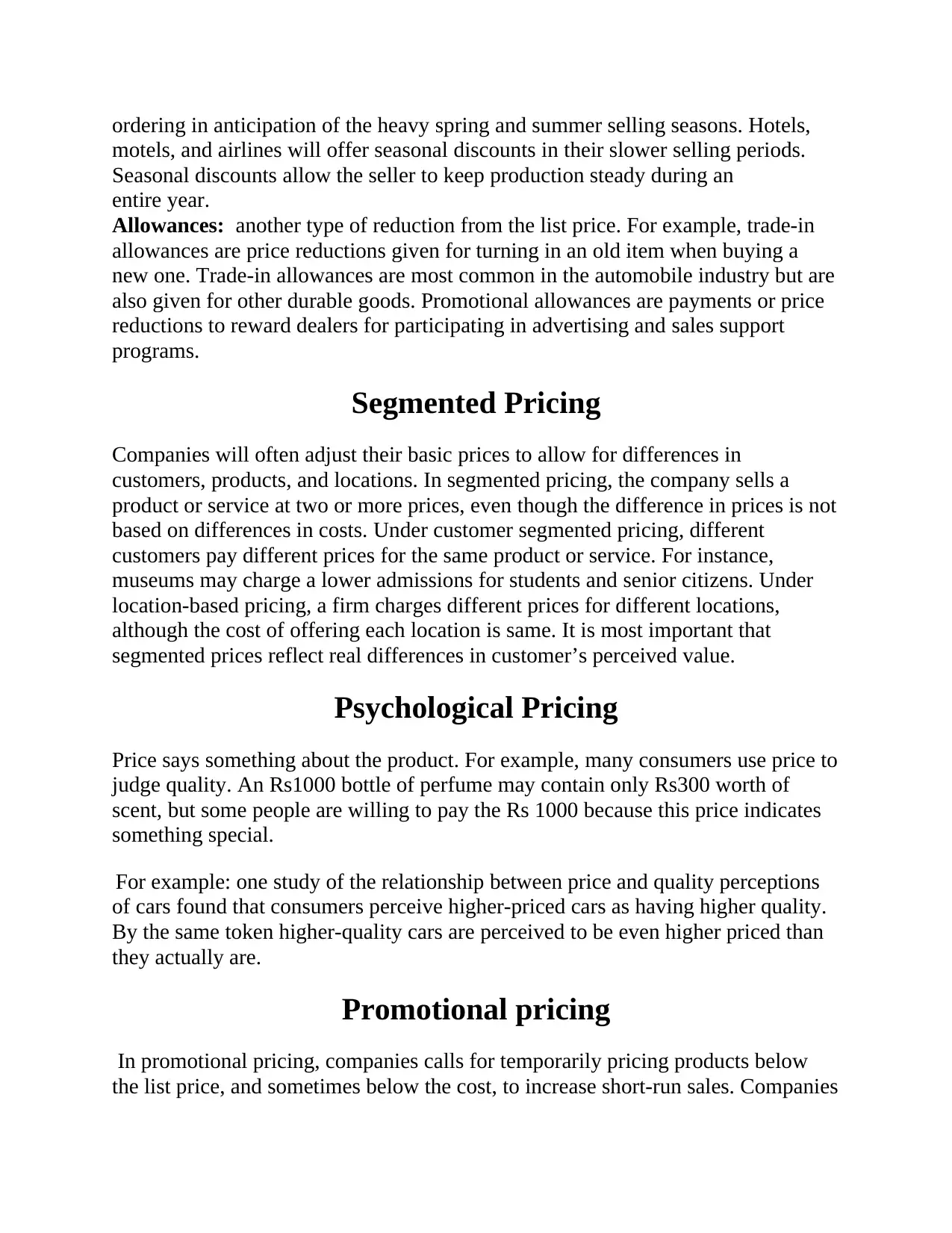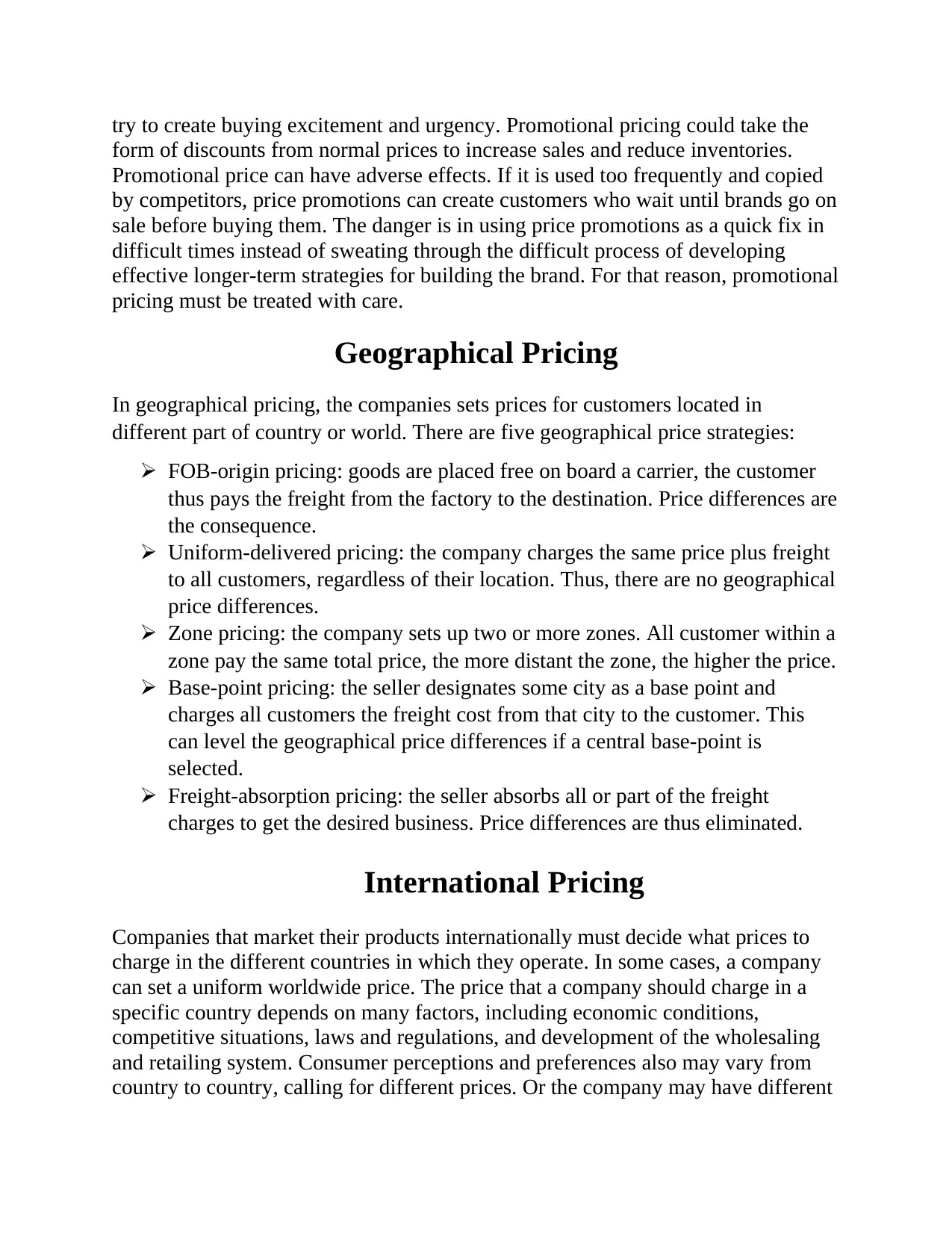SP20-BBA-022: Price Adjustment Strategies in Marketing Assignment
VerifiedAdded on 2021/06/14
|5
|1226
|699
Homework Assignment
AI Summary
This marketing assignment, submitted by Rehan Ullah from COMSAT University, explores various price adjustment strategies used by companies. The assignment delves into six key strategies: discount and allowance pricing (cash, quantity, functional, and seasonal discounts), segmented pricing (customer and location-based), psychological pricing (price-quality perception), promotional pricing, geographical pricing (FOB-origin, uniform-delivered, zone, base-point, and freight-absorption), and international pricing. The assignment highlights how companies modify their basic prices to cater to customer differences, market conditions, and economic factors. It provides examples of each strategy and discusses their impacts on customer behavior, business operations, and the overall economy. The document also touches upon the importance of considering costs, consumer perceptions, and competitive situations when setting prices, especially in international markets. The assignment emphasizes the significance of understanding and strategically implementing these price adjustment techniques to maximize sales and profitability.

Marketing
Assignment 04
Submitted to: Sir Mohammad Ali
Submitted by: Rehan ullah
Registration no: SP20-BBA-022
Submission date: 22 Dec, 2020
Department of Management Sciences
COMSAT University Islamabad, Abbottabad Campus
Price adjustment strategies
Companies usually adjust their basic prices to account for various customer
differences and changing situation. Price has direct impact on the customer,
Assignment 04
Submitted to: Sir Mohammad Ali
Submitted by: Rehan ullah
Registration no: SP20-BBA-022
Submission date: 22 Dec, 2020
Department of Management Sciences
COMSAT University Islamabad, Abbottabad Campus
Price adjustment strategies
Companies usually adjust their basic prices to account for various customer
differences and changing situation. Price has direct impact on the customer,
Paraphrase This Document
Need a fresh take? Get an instant paraphrase of this document with our AI Paraphraser

customer buying behavior, business and on the overall economy. There are six
price adjustment strategies
o Discount and allowance pricing
o Segment pricing
o Geographic pricing
o Psychological pricing
o Promotional pricing
o International pricing
Discount and Allowance Pricing
Most companies adjust their basic price to reward customers for certain responses,
such as early payment of bills, volume purchases, and off-season buying. These
price adjustments—called discounts and allowances—can take many forms.
Cash discount: is a price reduction to buyers who pay their bills promptly. A
typical example is "2/10, net 30," which means that although payment is due
within 30 days, the buyer can deduct 2
percent if the bill is paid within 10 days. The discount must be granted to all buyers
meeting these
terms. Such discounts are customary in many industries and help to improve the
seller’s cash situation and reduce bad debts and credit collection costs.
Quantity discount: is a price reduction to buyers who buy large
volumes. A typical example might be "Rs10 per unit for less than 100 units, Rs9
per unit for 100 or more.
Functional discount: also called a trade discount is offered by the seller to trade
channel members who perform certain functions, such as selling, storing, and
record keeping. Manufacturers may offer different functional discounts to different
trade channels because of the varying services they perform, but manufacturers
must offer the same functional discounts within
each trade channel.
Seasonal discount: is a price reduction to buyers who buy merchandise or services
out of season. For example, lawn and garden equipment manufacturers offer
seasonal discounts to retailers during the fall and winter months to encourage early
price adjustment strategies
o Discount and allowance pricing
o Segment pricing
o Geographic pricing
o Psychological pricing
o Promotional pricing
o International pricing
Discount and Allowance Pricing
Most companies adjust their basic price to reward customers for certain responses,
such as early payment of bills, volume purchases, and off-season buying. These
price adjustments—called discounts and allowances—can take many forms.
Cash discount: is a price reduction to buyers who pay their bills promptly. A
typical example is "2/10, net 30," which means that although payment is due
within 30 days, the buyer can deduct 2
percent if the bill is paid within 10 days. The discount must be granted to all buyers
meeting these
terms. Such discounts are customary in many industries and help to improve the
seller’s cash situation and reduce bad debts and credit collection costs.
Quantity discount: is a price reduction to buyers who buy large
volumes. A typical example might be "Rs10 per unit for less than 100 units, Rs9
per unit for 100 or more.
Functional discount: also called a trade discount is offered by the seller to trade
channel members who perform certain functions, such as selling, storing, and
record keeping. Manufacturers may offer different functional discounts to different
trade channels because of the varying services they perform, but manufacturers
must offer the same functional discounts within
each trade channel.
Seasonal discount: is a price reduction to buyers who buy merchandise or services
out of season. For example, lawn and garden equipment manufacturers offer
seasonal discounts to retailers during the fall and winter months to encourage early

ordering in anticipation of the heavy spring and summer selling seasons. Hotels,
motels, and airlines will offer seasonal discounts in their slower selling periods.
Seasonal discounts allow the seller to keep production steady during an
entire year.
Allowances: another type of reduction from the list price. For example, trade-in
allowances are price reductions given for turning in an old item when buying a
new one. Trade-in allowances are most common in the automobile industry but are
also given for other durable goods. Promotional allowances are payments or price
reductions to reward dealers for participating in advertising and sales support
programs.
Segmented Pricing
Companies will often adjust their basic prices to allow for differences in
customers, products, and locations. In segmented pricing, the company sells a
product or service at two or more prices, even though the difference in prices is not
based on differences in costs. Under customer segmented pricing, different
customers pay different prices for the same product or service. For instance,
museums may charge a lower admissions for students and senior citizens. Under
location-based pricing, a firm charges different prices for different locations,
although the cost of offering each location is same. It is most important that
segmented prices reflect real differences in customer’s perceived value.
Psychological Pricing
Price says something about the product. For example, many consumers use price to
judge quality. An Rs1000 bottle of perfume may contain only Rs300 worth of
scent, but some people are willing to pay the Rs 1000 because this price indicates
something special.
For example: one study of the relationship between price and quality perceptions
of cars found that consumers perceive higher-priced cars as having higher quality.
By the same token higher-quality cars are perceived to be even higher priced than
they actually are.
Promotional pricing
In promotional pricing, companies calls for temporarily pricing products below
the list price, and sometimes below the cost, to increase short-run sales. Companies
motels, and airlines will offer seasonal discounts in their slower selling periods.
Seasonal discounts allow the seller to keep production steady during an
entire year.
Allowances: another type of reduction from the list price. For example, trade-in
allowances are price reductions given for turning in an old item when buying a
new one. Trade-in allowances are most common in the automobile industry but are
also given for other durable goods. Promotional allowances are payments or price
reductions to reward dealers for participating in advertising and sales support
programs.
Segmented Pricing
Companies will often adjust their basic prices to allow for differences in
customers, products, and locations. In segmented pricing, the company sells a
product or service at two or more prices, even though the difference in prices is not
based on differences in costs. Under customer segmented pricing, different
customers pay different prices for the same product or service. For instance,
museums may charge a lower admissions for students and senior citizens. Under
location-based pricing, a firm charges different prices for different locations,
although the cost of offering each location is same. It is most important that
segmented prices reflect real differences in customer’s perceived value.
Psychological Pricing
Price says something about the product. For example, many consumers use price to
judge quality. An Rs1000 bottle of perfume may contain only Rs300 worth of
scent, but some people are willing to pay the Rs 1000 because this price indicates
something special.
For example: one study of the relationship between price and quality perceptions
of cars found that consumers perceive higher-priced cars as having higher quality.
By the same token higher-quality cars are perceived to be even higher priced than
they actually are.
Promotional pricing
In promotional pricing, companies calls for temporarily pricing products below
the list price, and sometimes below the cost, to increase short-run sales. Companies
⊘ This is a preview!⊘
Do you want full access?
Subscribe today to unlock all pages.

Trusted by 1+ million students worldwide

try to create buying excitement and urgency. Promotional pricing could take the
form of discounts from normal prices to increase sales and reduce inventories.
Promotional price can have adverse effects. If it is used too frequently and copied
by competitors, price promotions can create customers who wait until brands go on
sale before buying them. The danger is in using price promotions as a quick fix in
difficult times instead of sweating through the difficult process of developing
effective longer-term strategies for building the brand. For that reason, promotional
pricing must be treated with care.
Geographical Pricing
In geographical pricing, the companies sets prices for customers located in
different part of country or world. There are five geographical price strategies:
FOB-origin pricing: goods are placed free on board a carrier, the customer
thus pays the freight from the factory to the destination. Price differences are
the consequence.
Uniform-delivered pricing: the company charges the same price plus freight
to all customers, regardless of their location. Thus, there are no geographical
price differences.
Zone pricing: the company sets up two or more zones. All customer within a
zone pay the same total price, the more distant the zone, the higher the price.
Base-point pricing: the seller designates some city as a base point and
charges all customers the freight cost from that city to the customer. This
can level the geographical price differences if a central base-point is
selected.
Freight-absorption pricing: the seller absorbs all or part of the freight
charges to get the desired business. Price differences are thus eliminated.
International Pricing
Companies that market their products internationally must decide what prices to
charge in the different countries in which they operate. In some cases, a company
can set a uniform worldwide price. The price that a company should charge in a
specific country depends on many factors, including economic conditions,
competitive situations, laws and regulations, and development of the wholesaling
and retailing system. Consumer perceptions and preferences also may vary from
country to country, calling for different prices. Or the company may have different
form of discounts from normal prices to increase sales and reduce inventories.
Promotional price can have adverse effects. If it is used too frequently and copied
by competitors, price promotions can create customers who wait until brands go on
sale before buying them. The danger is in using price promotions as a quick fix in
difficult times instead of sweating through the difficult process of developing
effective longer-term strategies for building the brand. For that reason, promotional
pricing must be treated with care.
Geographical Pricing
In geographical pricing, the companies sets prices for customers located in
different part of country or world. There are five geographical price strategies:
FOB-origin pricing: goods are placed free on board a carrier, the customer
thus pays the freight from the factory to the destination. Price differences are
the consequence.
Uniform-delivered pricing: the company charges the same price plus freight
to all customers, regardless of their location. Thus, there are no geographical
price differences.
Zone pricing: the company sets up two or more zones. All customer within a
zone pay the same total price, the more distant the zone, the higher the price.
Base-point pricing: the seller designates some city as a base point and
charges all customers the freight cost from that city to the customer. This
can level the geographical price differences if a central base-point is
selected.
Freight-absorption pricing: the seller absorbs all or part of the freight
charges to get the desired business. Price differences are thus eliminated.
International Pricing
Companies that market their products internationally must decide what prices to
charge in the different countries in which they operate. In some cases, a company
can set a uniform worldwide price. The price that a company should charge in a
specific country depends on many factors, including economic conditions,
competitive situations, laws and regulations, and development of the wholesaling
and retailing system. Consumer perceptions and preferences also may vary from
country to country, calling for different prices. Or the company may have different
Paraphrase This Document
Need a fresh take? Get an instant paraphrase of this document with our AI Paraphraser

marketing objectives in various world markets, which require changes in pricing
strategy. Costs play an important role in setting international prices. Travelers
abroad are often surprised to find that goods that are relatively inexpensive at home
may carry outrageously higher price tags in other countries. In some cases, such
price escalation may result from differences in selling strategies or
market conditions. In most instances, however, it is simply a result of the higher
costs of selling in foreign markets—the additional costs of modifying the product,
higher shipping and insurance costs, import tariffs and taxes, costs associated with
exchange-rate fluctuations, and higher channel and physical distribution costs.
strategy. Costs play an important role in setting international prices. Travelers
abroad are often surprised to find that goods that are relatively inexpensive at home
may carry outrageously higher price tags in other countries. In some cases, such
price escalation may result from differences in selling strategies or
market conditions. In most instances, however, it is simply a result of the higher
costs of selling in foreign markets—the additional costs of modifying the product,
higher shipping and insurance costs, import tariffs and taxes, costs associated with
exchange-rate fluctuations, and higher channel and physical distribution costs.
1 out of 5
Related Documents
Your All-in-One AI-Powered Toolkit for Academic Success.
+13062052269
info@desklib.com
Available 24*7 on WhatsApp / Email
![[object Object]](/_next/static/media/star-bottom.7253800d.svg)
Unlock your academic potential
Copyright © 2020–2025 A2Z Services. All Rights Reserved. Developed and managed by ZUCOL.





